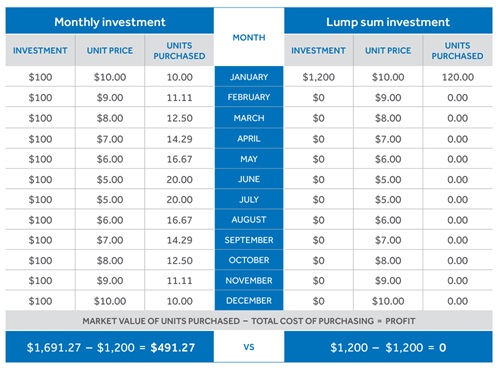Everyone knows when it comes to investing, you want to buy low and sell high. It’s when you've bought high and then see an investment dip lower in value that the stress kicks in. But there are ways to counter that.
What is dollar cost averaging?
Dollar cost averaging (DCA) is an investment strategy for those who are a little more conservative, a little more risk-averse. It’s for people who want to minimize volatility in their portfolio.
It’s a technique used to help reduce the risk of timing a single sum investment, says Charissa Cummings, Senior Wealth Advisor, Servus Wealth Strategies and Aviso Wealth. You buy the same dollar amount of an investment in regular intervals – regardless of the price of the asset – as opposed to spending all your money on a security at once. You can ease into the market over time. It lessens the emotional impact that comes with any drop in the market.
“It’s really good to soften that initial concern and fear of investing,” she says. “It gets the investor away from having to time the market.”
There are two ways to fund a DCA strategy. You can regularly invest a portion of your paycheque or make the same dollar amount investments pulling from a lump-sum of savings you have set aside.
What are the benefits?
Many investors find it easier to tuck away a smaller amount of money for investments as part of a regular payment schedule like one finds in a DCA scenario. That's where the psychology benefits lie.
Charissa says she likes the strategy for some of her members. Getting caught up in the fear and excitement as markets fluctuate happens to too many investors. People buy out of excitement or they sell out of depression. A strategy like dollar cost averaging brings rationality into the process. The risk of overpaying in an investment decreases.
What are the negatives?
The downside to all this is if the share price soars and you are still playing the “steady Eddie”, longer-term game, buying the asset at an average price, you’ll miss out on the party. That’s a chance some people are willing to take, especially if DCA is part of an overall strategy that better fits their personality and comfort zone.
“When you understand your investment, and understand how it helps you, it helps take the emotion out,” Charissa says. “The more educated people are, the more comfortable they are about the financial strategy they have.”

Is it right for you?
In a scenario where you have set up a pre-authorized contribution plan (PAC) that automatically transfers a pre-determined amount of money from your bank account to your investment account, you pick the regularity of the transfers and the amount you want to transfer.
“A stronger savings habit comes out of it,” Charissa says. “You learn discipline. You gain comfort and confidence over the long term.”
As any advisor will tell you, the whole idea of buying when a stock is low, or selling when it’s high, is very difficult to do. “If you invest regularly you are going to buy more when it’s low, and not as much when it’s high,” she says.
One member had a large sum of money after selling their farm, and wanted to invest the proceeds, but valuations in the market were high.
“This was their life savings,” Charissa says. “It was going to give them income in retirement. They were more concerned and cautious, and they were asking if this was the best time to be investing. And so with the DCA, they made gradual purchases over time.”
What’s better? Making a long-range lump sum investment and letting the market fluctuate or employing a dollar cost averaging strategy? Charissa favours the latter. A lump sum, invested over a long period of time as part of an overall portfolio, where members are successful in keeping their emotions in check, is a better way to go.

Source: NEI Investing Basics Guidebook
“It’s better to have a well thought-out plan,” she says. “It’s typically better to get invested and stay invested. And the sooner you get invested the better, with the power of compounding over time in the market.”
Still, the worry of losing money is very much at the forefront of a lot of people's minds when they get into investing. Walking into the ocean as opposed to jumping into the deeper water is an understandable approach if that better suits your risk tolerance.
Mutual funds and other securities are offered through Aviso Wealth, a division of Aviso Financial Inc. Commissions, trailing commissions, management fees and expenses all may be associated with mutual fund investments. Please read the prospectus before investing. Unless otherwise stated, mutual fund securities and cash balances are not insured nor guaranteed, their values change frequently and past performance may not be repeated.
Servus Wealth Strategies Ltd. is a subsidiary of Servus Credit Union Ltd. offering financial planning, life insurance and investments.

